Joshua Tree National Park
When devout Mormon pioneers crossed this faith-testing desert in the 19th century, they named the enigmatic tree they encountered after the Biblical prophet Joshua. The tree's crooked limbs resembled the Hebrew general, who, with his arms upraised, seemed to beckon them to the promised land. (Let's Go USA 2002)
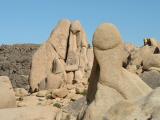
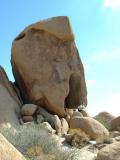
We had not heard anything about the Joshua Tree National Park but given it is a National Park, and one of the closest to LA, we thought we'd go and take a look. Well, we were amazed. We drove there on Saturday morning and had lunch in a picnic area surrounded by boulders. The only problem with the desert is the lack of shade, so we had to eat in the car. Rob tried climbing some of the rocks (a recurring theme) and we went for a wander around some of them. There were some interesting shapes!
The National Park Service holds
Ranger Programs where a ranger will lead a walk, or a slide show, and talk about a particular aspect of the National Park. These are free, and we have been very impressed by them.
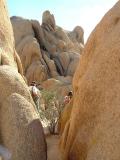
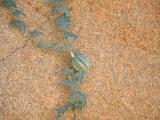
We went on a Geology walk with a Ranger from one of the campsites along a trail where he told us about the how the rock formations were formed. The majority of the park consists of granite which was formed by a ball of magma that rose under the earth and then cooled, and then, over time, the top rock and soil were eroded exposing the granite. The recurring themes were water, and heating and cooling. In the desert the cooling is as important for the geology as the heating (which we usually associate with the desert). Over night the temperature often drops below freezing and so any moisture in fine cracks in the rocks expands and this causes the surface of the rocks to slowly erode. The regular cubic block shape is mainly by erosion, though the regular earth movements (it's quite near the San Andreas Fault) may have assisted. On the walk we passed through narrow gaps between huge rocks, saw a natural arch, and learnt about where to find water in the desert - how Coyotes do. We also saw a native melon growing over a rock.
Fortunately the weather was not too hot - no higher than 25C in the shade, but the sun was very hot.
We went for a walk through a field of Cacti - Teddy Bear Cacti as they are commonly known, or Cholla (pronounced Choy-ya) Cactus, which are known for their extreme sharpness. We also saw an unusual cacti - the Ocotillo, which consists of long slender canes covered in tiny leaves.
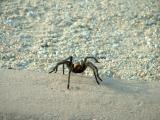
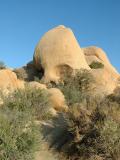
Rob had been hoping to see some of the wildlife and apart from small lizards, there didn't seem to be a lot around, especially during the heat of the day.Then as we were pulling into a parking spot, he noticed a Tarantula climbing the kerb. It was amazing to see - they are an intruiging arachnid - they are not poisonous to humans (though their bite is said to be very painful) and they can live over 30 years, inhabiting the same burrow for many years. Rob was happy, but would still like to see a Sidewinder or Rattlesnake.
Skull Rock was somewhat disappointing, and we walked a mile to find that it had been right infront of us when we parked the car. Looking at it now, it does look like a skull, but Rob was looking for something more skull like.
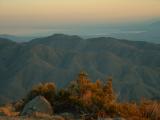
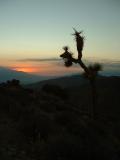
Keys View is a lookout at 5185ft and from there we, and many others, watched the sunset across a huge valley and through the smog which blows in from the LA area.
Booking last minute doesn't always work as well as we might hope, and Saturday night was spent in a hotel just out of Palm Springs, an hours drive from the National Park. We passed many suitable (and suitably priced) hotels in the hours drive, which we might have known about had we actually done any research.
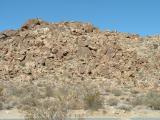
Sunday we drove in the southern entrance to the park, and searched for the spring at Cottonwood Springs, but only saw a couple of drips coming off some rocks. We drove through the Pinto Basin, and we amazed by the scenery (having been told it was a long boring drive).
We drove to Hidden Valley and on the way, hit a large rock which made Rob start concentrating on the road more than the scenery. Not until after lunch did we realise that the collision had caused the hub cap to fly off, and we had to retract our steps (with an every depleting tank of petrol) and eventually located the hubcap - in one piece. We took a walk through Hidden Valley which was completely surrounded by rocky outcrops - hence being hidden. We saw lots of rock climbers, and Rob tried making it to the top the easy way without a rope, but was thwarted by the sight of a somewhat worried Jo at the bottom of the cliff. It was interesting to see the Pinion Pines which had adapted to the dry conditions - they were often quite scraggly, and were at their highest concentration inside Hidden Valley.
Outside Hidden Valley were some 'forests' of Joshua Trees.
On the drive home we passed a huge wind farm, the biggest we'd ever seen (not that we've seen many).





 We went on a Geology walk with a Ranger from one of the campsites along a trail where he told us about the how the rock formations were formed. The majority of the park consists of granite which was formed by a ball of magma that rose under the earth and then cooled, and then, over time, the top rock and soil were eroded exposing the granite. The recurring themes were water, and heating and cooling. In the desert the cooling is as important for the geology as the heating (which we usually associate with the desert). Over night the temperature often drops below freezing and so any moisture in fine cracks in the rocks expands and this causes the surface of the rocks to slowly erode. The regular cubic block shape is mainly by erosion, though the regular earth movements (it's quite near the San Andreas Fault) may have assisted. On the walk we passed through narrow gaps between huge rocks, saw a natural arch, and learnt about where to find water in the desert - how Coyotes do. We also saw a native melon growing over a rock.
We went on a Geology walk with a Ranger from one of the campsites along a trail where he told us about the how the rock formations were formed. The majority of the park consists of granite which was formed by a ball of magma that rose under the earth and then cooled, and then, over time, the top rock and soil were eroded exposing the granite. The recurring themes were water, and heating and cooling. In the desert the cooling is as important for the geology as the heating (which we usually associate with the desert). Over night the temperature often drops below freezing and so any moisture in fine cracks in the rocks expands and this causes the surface of the rocks to slowly erode. The regular cubic block shape is mainly by erosion, though the regular earth movements (it's quite near the San Andreas Fault) may have assisted. On the walk we passed through narrow gaps between huge rocks, saw a natural arch, and learnt about where to find water in the desert - how Coyotes do. We also saw a native melon growing over a rock.
 Rob had been hoping to see some of the wildlife and apart from small lizards, there didn't seem to be a lot around, especially during the heat of the day.Then as we were pulling into a parking spot, he noticed a Tarantula climbing the kerb. It was amazing to see - they are an intruiging arachnid - they are not poisonous to humans (though their bite is said to be very painful) and they can live over 30 years, inhabiting the same burrow for many years. Rob was happy, but would still like to see a Sidewinder or Rattlesnake.
Rob had been hoping to see some of the wildlife and apart from small lizards, there didn't seem to be a lot around, especially during the heat of the day.Then as we were pulling into a parking spot, he noticed a Tarantula climbing the kerb. It was amazing to see - they are an intruiging arachnid - they are not poisonous to humans (though their bite is said to be very painful) and they can live over 30 years, inhabiting the same burrow for many years. Rob was happy, but would still like to see a Sidewinder or Rattlesnake.
 Keys View is a lookout at 5185ft and from there we, and many others, watched the sunset across a huge valley and through the smog which blows in from the LA area.
Keys View is a lookout at 5185ft and from there we, and many others, watched the sunset across a huge valley and through the smog which blows in from the LA area.